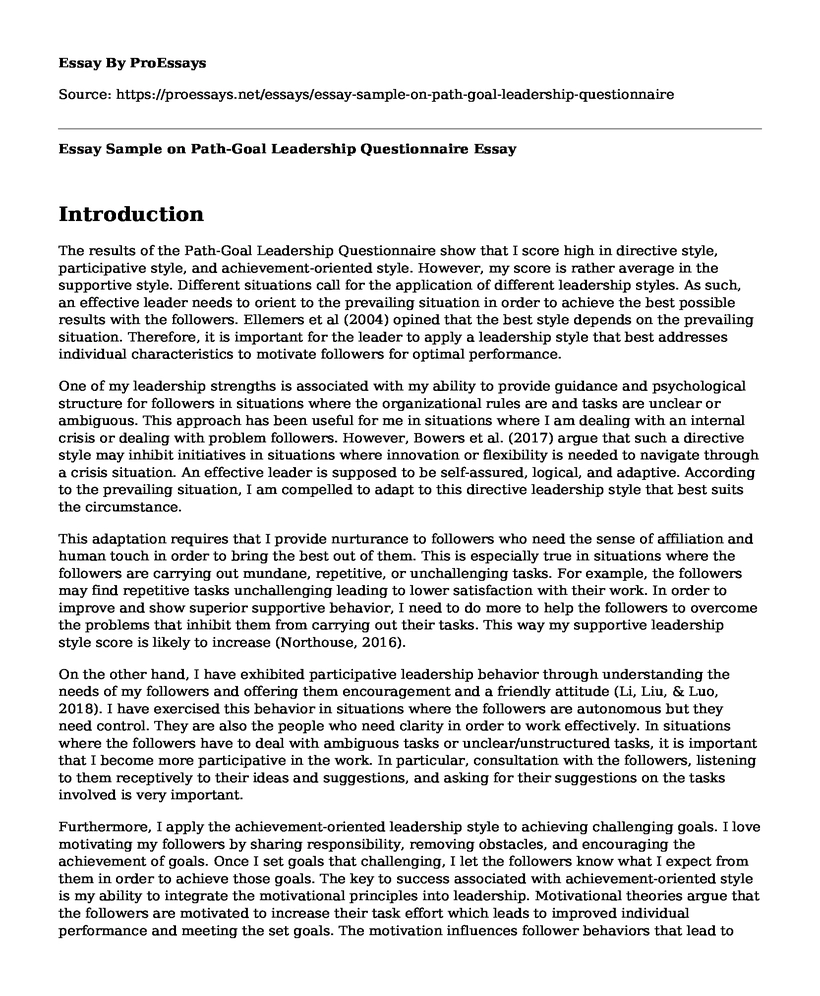Introduction
The results of the Path-Goal Leadership Questionnaire show that I score high in directive style, participative style, and achievement-oriented style. However, my score is rather average in the supportive style. Different situations call for the application of different leadership styles. As such, an effective leader needs to orient to the prevailing situation in order to achieve the best possible results with the followers. Ellemers et al (2004) opined that the best style depends on the prevailing situation. Therefore, it is important for the leader to apply a leadership style that best addresses individual characteristics to motivate followers for optimal performance.
One of my leadership strengths is associated with my ability to provide guidance and psychological structure for followers in situations where the organizational rules are and tasks are unclear or ambiguous. This approach has been useful for me in situations where I am dealing with an internal crisis or dealing with problem followers. However, Bowers et al. (2017) argue that such a directive style may inhibit initiatives in situations where innovation or flexibility is needed to navigate through a crisis situation. An effective leader is supposed to be self-assured, logical, and adaptive. According to the prevailing situation, I am compelled to adapt to this directive leadership style that best suits the circumstance.
This adaptation requires that I provide nurturance to followers who need the sense of affiliation and human touch in order to bring the best out of them. This is especially true in situations where the followers are carrying out mundane, repetitive, or unchallenging tasks. For example, the followers may find repetitive tasks unchallenging leading to lower satisfaction with their work. In order to improve and show superior supportive behavior, I need to do more to help the followers to overcome the problems that inhibit them from carrying out their tasks. This way my supportive leadership style score is likely to increase (Northouse, 2016).
On the other hand, I have exhibited participative leadership behavior through understanding the needs of my followers and offering them encouragement and a friendly attitude (Li, Liu, & Luo, 2018). I have exercised this behavior in situations where the followers are autonomous but they need control. They are also the people who need clarity in order to work effectively. In situations where the followers have to deal with ambiguous tasks or unclear/unstructured tasks, it is important that I become more participative in the work. In particular, consultation with the followers, listening to them receptively to their ideas and suggestions, and asking for their suggestions on the tasks involved is very important.
Furthermore, I apply the achievement-oriented leadership style to achieving challenging goals. I love motivating my followers by sharing responsibility, removing obstacles, and encouraging the achievement of goals. Once I set goals that challenging, I let the followers know what I expect from them in order to achieve those goals. The key to success associated with achievement-oriented style is my ability to integrate the motivational principles into leadership. Motivational theories argue that the followers are motivated to increase their task effort which leads to improved individual performance and meeting the set goals. The motivation influences follower behaviors that lead to improved performance (Goswami, Beehr, & Goffnett, 2014).
Conclusion
The hallmark of becoming an effective leader is being able to apply leadership behaviors that are consistent with the followers' characteristics as well as tasks characteristics (Sethuraman & Suresh, 2014). While I perform well in directive, participative, and achievement-oriented styles, the challenge is to improve my skill set associated with supportive behavior to become a more accomplished leader.
References
Bowers, M. R., Hall, J. R., & Srinivasan, M. M. (2017). Organizational culture and leadership style: The missing combination for selecting the right leader for effective crisis management. Business Horizons, 60(4), 551-563.
Ellemers, N., De Gilder, D., & Haslam, S. A. (2004). Motivating individuals and groups at work: A social identity perspective on leadership and group performance. Academy of Management Review, 29(3), 459-478.
Goswami, A., Li, M., Beehr, T. A., & Goffnett, S. P. (2014). Path-Goal Leaders' Behaviors and Subordinates' Personalities: Resulting Subordinates' Behaviors. In Academy of Management Proceedings (Vol. 2014, No. 1, p. 11888). Briarcliff Manor, NY 10510: Academy of Management.
Li, G., Liu, H., & Luo, Y. (2018). Directive versus participative leadership: Dispositional antecedents and team consequences. Journal of Occupational and Organizational Psychology, 91(3), 645-664.
Sethuraman, K., & Suresh, J. (2014). Effective leadership styles. International Business Research, 7(9), 165.
Cite this page
Essay Sample on Path-Goal Leadership Questionnaire. (2022, Aug 08). Retrieved from https://proessays.net/essays/essay-sample-on-path-goal-leadership-questionnaire
If you are the original author of this essay and no longer wish to have it published on the ProEssays website, please click below to request its removal:
- Product Usability Study: Coffee Machine
- Business Sustainability Plan - Paper Example
- Essay Sample on Human Resource Information System
- Project Management: Comp. UG Sprinkler Sys & Stakeholder Management - Essay Sample
- Research Paper on Disney's Low-Cost Integrated Differentiation Strategy
- Essay Example on DuPont Model: Essential Financial Analysis Framework
- Report Paper Sample on QuikTrip's Plan: Investing Heavily in Workforce for Competitiveness







